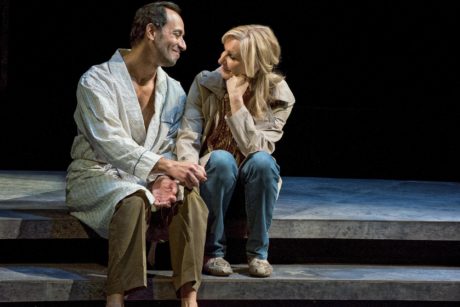Los Otros, now on stage at Everyman Theatre in Baltimore is a musical in transition.
The version audiences in Baltimore are seeing now is different from what audiences in Los Angeles viewed at the Mark Taper forum five years ago. It may remain the same as audiences saw it opening night at the Everyman – or it may continue to evolve. However, considering the current political climate and threats by our 45th President of a “Great Wall” being erected along our southern border to keep out “rapists and criminals” and undocumented aliens, this show couldn’t be more timely.
Los Otros, which translated means “The Others,” features a book and lyrics by Ellen Fitzhugh, and Music by Composer Michael John LaChiusa. The original production was revived and revised during a workshop in New York City last summer. The current production is directed by Noah Himmelstein. Jon Kalbfleisch is the musical director and orchestrations for the six musicians were by Bruce Coughlin.

The set, designed by Daniel Ettinger, appears to be simple. A series of 20-foot tall wood panels, pierced by a lacy, interwoven and Mexican-inspired design, can be rolled silently back and forth as needed. Backlit with changing lights designed by Nancy Schertler, they cast their open, lacework shadows on the narrow upper stage and, a couple steps down, on a small stage projecting slightly into the audience. It has been painted in a colorful, south-of-the-border pattern. In front of the panels are two square, modern columns. Stage right is a narrow, tall stacked stone wall and, next to it, an Ikea-type bookshelf and a low table or bench. Stage Left is a pair of conjoined chairs, one facing outward, the other facing the panel.
Behind the panel Stage Left, the musicians perform on a two-tiered set. Conductor Jon Kalbfleisch does double duty on the keyboard. Los Otros is a musical, but if you come expecting a roaring chorus, marching bands, lyrics you can sing later in the shower, and exploding special effects and flying chandeliers, you’ll be disappointed.
This show features two actors in the cast and nearly all the dialog is sung. As they sing it – you can see the scene they are describing and feel the depth of their emotions.
On opening night Director Noah Himmelstein faced the sold out house and gave a short introduction. “Fewer and fewer theaters in America are doing new work,” he said, noting the cast and the creative team, including Ellen Fitzhugh and Michael John LaChiusa, worked together for five weeks “making this as rich and as powerful as we can.”
The show’s timeline, relived by Philip Hernandez as Carlos and Judy McLane as Lillian, spans seven decades from 1938 to 1995, in coastal towns in southern California and in Mexico.
Lillian, dressed in a short khaki trench coat, a camisole, jeans and woven leather flats, storms down a side aisle onto the stage. She sets the tone by singing in a voice best described as awesome. Even singing a grocery list, this singer-actress would probably draw an appreciative crowd.
The time is 1952. Lillian describes how she and her two younger sisters witness a Mexican couple fleeing north leap from a passing train with a baby in the mother’s arms. The girls, not yet pre-teens, know the Mexicans will seek refuge in a nearby cave before continuing on their journey to freedom. The girls feel they have an obligation to help them. Lillian recounts how they sneak out of their home at night with stolen food and place it where the Mexicans can find it.
Carlos, a Mexican-American, is introduced as Philip Hernandez appears to be showering in front of the stacked stone wall. The barefoot and bare chested man, born in the U.S., sings of his family’s escape to El Norte after a violent, deadly hurricane.
His voice is deep, rich, strong and rises over the audience. His range, and that of his co-star, is aided and amplified by the sound design of Ken Travis and nearly invisible mic wires.
The scene shifts to Lillian. It’s 1967 and she’s now the divorced mother of two girls, with an attentive ex-husband. With the ex’s assistance, she has driven to Mexico to bring back a nanny – locked in the trunk of her car. The arrangement works well for several years.
Back to Carlos who remembers being called a wetback by a Mr. Harvington, the owner of an orchard where he spends his summers during the Great Depression and World War II picking and packing fruit. In school, his teachers yell at him and his classmates if they dare speak in Spanish.

Moving further along the timeline, a lonely Lillian makes a suggestion to a handsome 18-year old Hispanic virgin and follows him back to the warehouse where he’s living with other young Mexican men. It doesn’t matter that her youngest daughter is now 15.
Later on, as a senior citizen, living in a house filled with luxurious Lalique crystal, Carlos is an accountant. He and his longtime partner, an Anglo, are gay.
Eventually, the two characters – and the audience – realize Carlo and Lilian’s lives have been touched, impacted and become intertwined over the decades by each other’s actions, cultural identity and sexuality.
All of this set against the backdrop of Michael John LaChiusa’s score – a blend of classical and pop music, accented with Mexican folk and mariachi music. (Occasionally, though, the music’s volume made it hard to follow what the actors were singing.)
The audience, watching the changing attitudes toward “the other” – the other’s culture, language, history and opportunity – has to confront its own attitudes about “the other.” How different are we, really? How far have we come? How far do we have to go? And, how much will be forever changed by the world’s current events?
Los Otros is a timely, thought-provoking show for our times. The audience gave it a well-earned standing ovation.
Running Time: Approximtely 90 minutes, with no intermission.
Los Otros plays through April 23, 2017, at Everyman Theatre – 315 West Fayette Street, in Baltimore, MD. For tickets, call the box office at (410) 752-2208, or purchase them online.
LINK:
David Gerson’s review on DCMetroTheaterArts.





